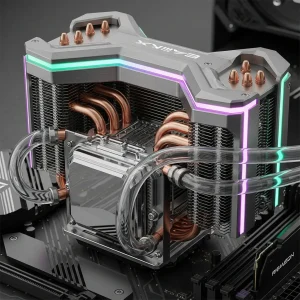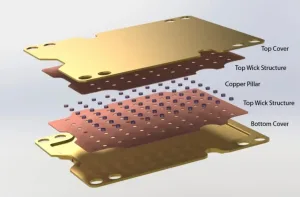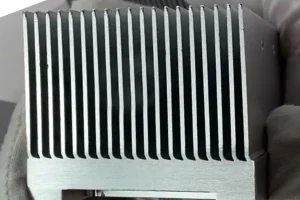Four Performance Parameters You Must Check When Selecting a Thermoelectric Cooler
When selecting a semiconductor cooler, its comprehensive performance (such as cooling capacity, heat dissipation capacity, etc.) is what we focus on. These comprehensive performances of the semiconductor cooler are mainly determined by four performance parameters: Imax, Vmax, DTmax, and Qcmax. Let’s take a look at what these parameters mean respectively.
Semiconductor Cooler Related Performance Parameters
① Imax (Maximum Current):
The current value passing through the TEC when the temperature difference ΔT between the heat dissipation surface and the heat absorption surface reaches its maximum value. At this moment, the heat absorption amount Qc of the TEC is 0. Imax reflects the current limit of the TEC under the condition of the maximum temperature difference.
② Vmax (Maximum Voltage):
The voltage value across the two ends of the TEC when the maximum current value Imax is applied. At this moment, the heat absorption amount Qc of the TEC is 0. Vmax reflects the voltage limit of the TEC under the condition of the maximum current.
③DTmax:
When the maximum current value Imax is applied, the maximum temperature difference ΔT (Th – Tc) between the heat dissipation surface and the heat absorption surface of the TEC. At this moment, the heat absorption amount Qc of the TEC is 0. DTmax reflects the maximum cooling capacity of the TEC. Generally speaking, on the premise that the temperature of the hot surface is the same, the larger the DTmax, the better the performance of the semiconductor material.
④Qcmax:
The heat absorption amount of the TEC when the maximum current value Imax is applied. At this moment, the temperature difference ΔT between the heat absorption surface and the heat dissipation surface is 0. Qcmax reflects the maximum cooling capacity of the TEC under the optimal working conditions.
Calculation Method / TEC-12706
The performance parameters of the TEC can not only obtain theoretical values through simulation calculations but also obtain measured values through experimental tests.
The following table is the performance parameter table of TEC-12706 when the hot surface temperature Th = 50℃.
When the maximum temperature difference / maximum cooling capacity is known, how can we calculate the values of other performance parameters?
We will calculate and explain it for you by applying the formula.
| Item | Value | Test Conditions |
|---|---|---|
| Maximum Current Value | Imax: 6.0A | Qc = 0, DT = DTmax, Th = 50℃ |
| Maximum Input Voltage | Vmax: 18.1V | Qc = 0, I = Imax, Th = 50℃ |
| Maximum Temperature Difference | DTmax: 83℃ | Qc = 0, I = Imax, Th = 50℃ |
| Maximum Heat Absorption | Qcmax: 56.7W | I = Imax, DT = 0, Th = 50℃ |
▲ TEC-12706 Performance Parameters
Calculation Method / TEC-12706
● DT = Th – Tc, which means the temperature difference is equal to the hot – surface temperature minus the cold – surface temperature.
● V = Sm * DT + I * Rm, that is, the input voltage equals the power generated by the temperature difference plus the result calculated by Ohm’s law.
● Qh = Qc + V * I, namely, the heat release is equal to the heat absorption plus the product of voltage and current.
- Here, Sm is the Seebeck coefficient of the semiconductor material, and Rm is the resistance of the semiconductor cooler. Both are dynamic values that vary with temperature.
① When the maximum temperature difference DTmax = 83℃,
Qc = 0
Tc = Th – DT = 50℃ – 83℃ = – 33℃
I = Imax = 6.0A, V = Vmax = 18.1V
Qh = Qc + V * I = 0 + 18.1V * 6A = 108.6W
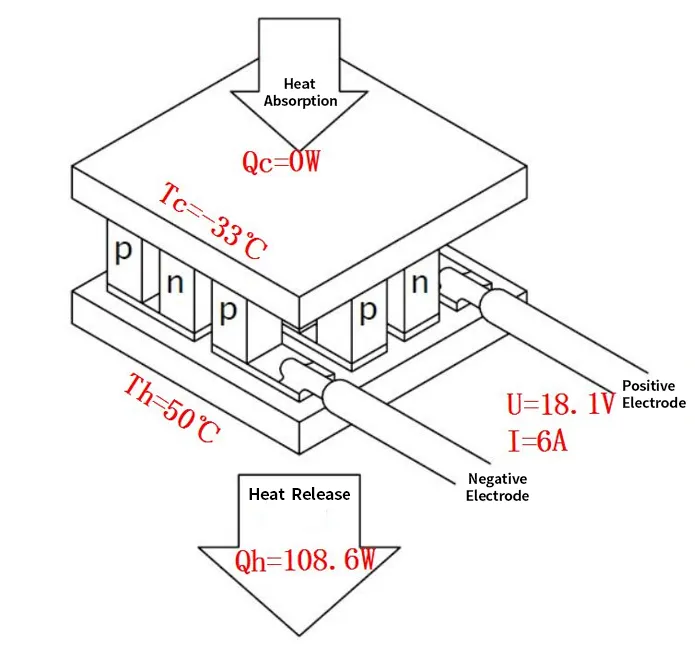
▲ The maximum temperature difference DTmax is 83℃, and the heat release Qh is 108.6W. W
Tc = Th – DT = 50℃ – 0 = 50℃
Qc = Qcmax = 56.7W, I = Imax = 6.0A
V = Sm * DT + I * Rm = Sm * 0 + 6A * 2.75Ω = 16.5V
- By checking the drawing of 12706, the resistance value at 25℃ is 2.18 – 2.68Ω, and the average resistance value is 2.43Ω. According to the material characteristics, the resistance value increases by 0.5% for each degree of temperature rise. Therefore, the resistance value Rm at 50℃ is 2.75Ω.
Qh = Qc + V * I = 56.7W + 16.5V * 6A = 155.7W
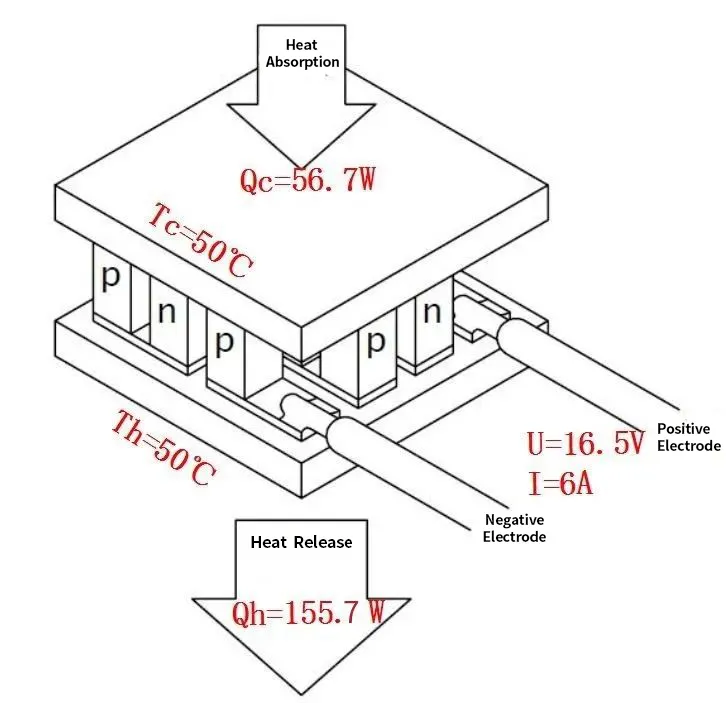
▲ When the maximum cooling capacity Qcmax is 56.7W, the heat release Qh is 155.7W.
Understand the Performance Relationship Diagram / TEC - 12706
In addition to calculations, you can also comprehensively understand the performance of the TEC under different working conditions by referring to the four performance relationship diagrams (Qc, V, Qh, COP & I) (all under the condition of a constant hot – surface temperature).
In practical application scenarios, it helps users optimize the application configuration of the TEC.
① Qc vs I Diagram: A diagram showing the relationship between the input current and the cooling power at different temperature differences ▼
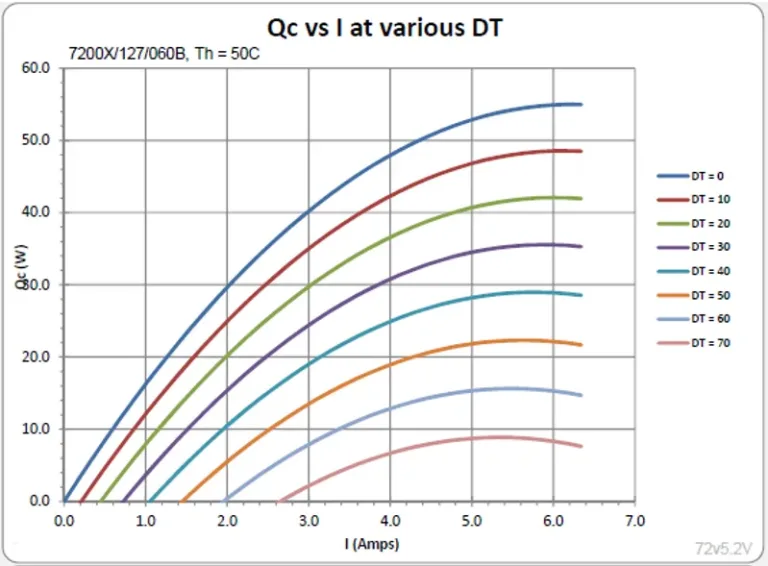
• Purpose of the curve: Confirm whether the TEC has sufficient cooling capacity to meet the application requirements.
• Confirm the cooling capacity: Ensure that the cooler can provide sufficient cooling power.
• Select the appropriate operating point: Find the optimal combination of input current and temperature difference to make the TEC operate within the high-efficiency range.
② Qh vs I Diagram: A diagram showing the relationship between the input current and the heat dissipation power of the hot surface at different temperature differences ▼
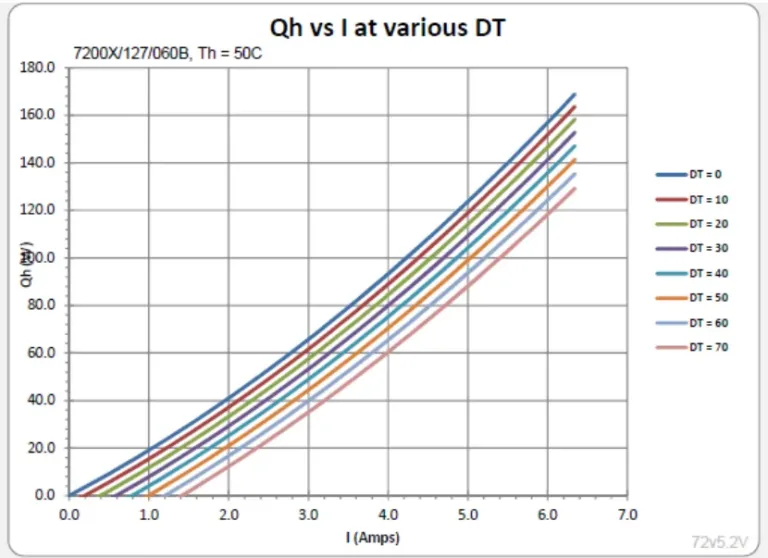
• Purpose of the curve: Confirm whether the radiator has sufficient heat dissipation capacity to meet the application requirements.
• Confirm the heat dissipation capacity: Ensure that the heat dissipation power is sufficient for the system to effectively handle the heat generated by the TEC.
• Select the appropriate operating point: According to the actual required cooling effect, find the corresponding input current and the corresponding heat dissipation power of the hot surface.
③ V vs I Diagram: A diagram showing the relationship between the input current and the voltage at different temperature differences ▼
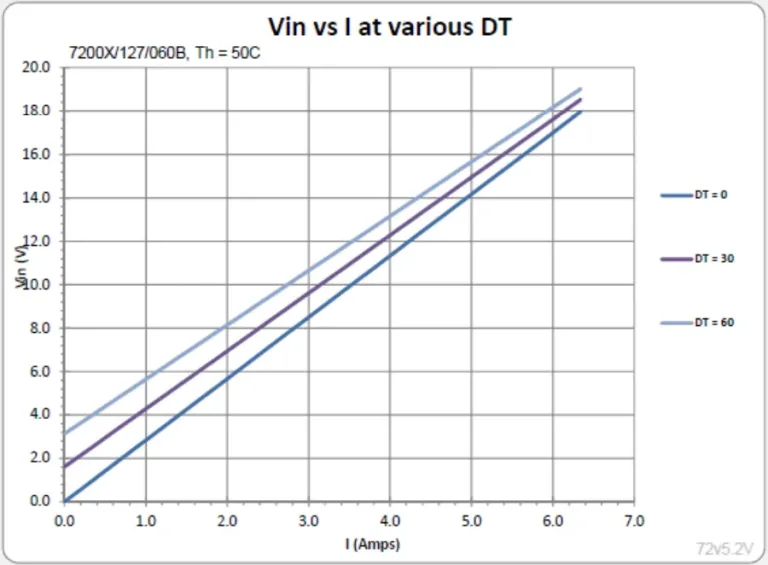
• Purpose of the curve: After selecting the TEC model, determine the value of the power supply voltage it requires under specific working conditions.
• Select the appropriate operating point: Users can first determine the appropriate input current and temperature difference through the Qc vs I curve diagram, and then find the corresponding power supply voltage value through the V vs I curve diagram to ensure that the provided power supply voltage matches the operating voltage of the TEC.
• Optimize the power supply configuration: By reasonably selecting the power supply voltage, make the TEC operate in the high-efficiency range and avoid low efficiency or equipment damage caused by insufficient or excessive voltage.
④ COP vs I Diagram: A diagram showing the relationship between the input current and COP (cooling efficiency) at different temperature differences ▼
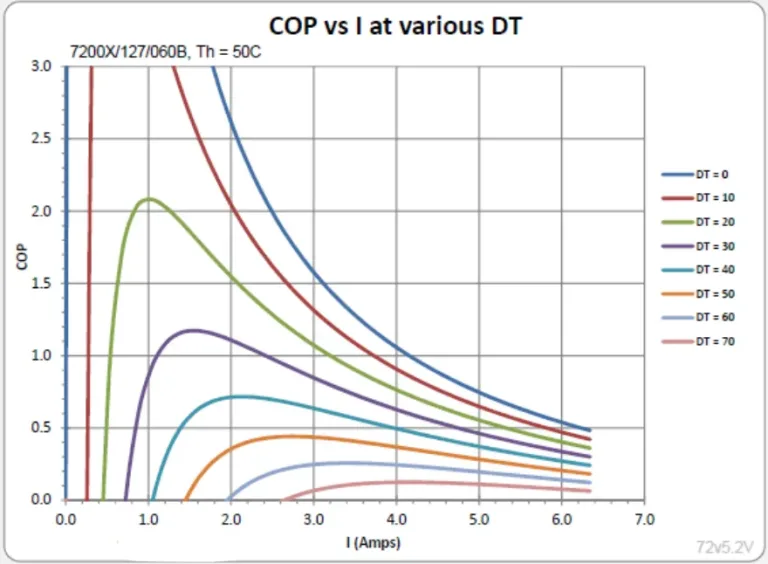
• Purpose: Determine the COP (the COP coefficient is the ratio of the cooling power to the input power) to achieve the maximization of the cooling capacity and the minimization of the input power (power consumption).
• Determine the optimal operating point: Users can find the maximum COP value at a specific temperature difference through this curve and select the corresponding input current to ensure that the TEC operates in the high-efficiency range.
• Optimize energy consumption: Adjust the input current. While ensuring sufficient cooling power, try to reduce the input power (lower power consumption) and improve the overall efficiency of the system.

